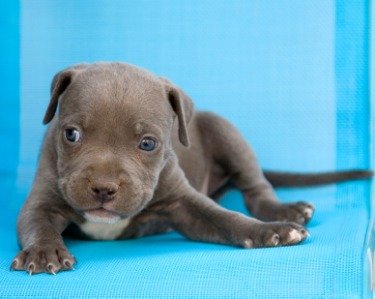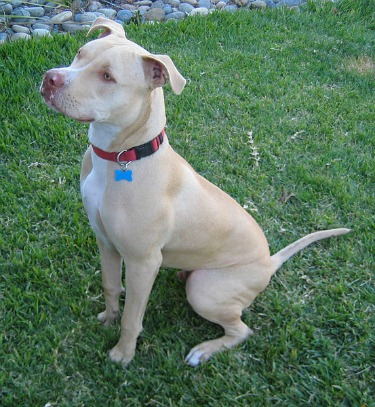|
Dog Breed of the Month: The American Pitbull TerrierEach month, Buster shines the spotlight on a different dog breed. This month's feature is the American Pitbull Terrier, possibly the most misunderstood--and maligned--of dog breeds.
Origins The American Pitbull Terrier has its origins in England and Ireland in the nineteenth century, when bulldogs were cross-bred with terriers to get the agility and speed of the terrier along with the strength and athleticism of the bulldog. (Yeah, I know you're thinking, 'Wait a minute...bulldogs are couch potatoes.' But that's not how they used to be. Maybe that's an idea for the next breed of the month!) The crossbred dogs became known as either the American Staffordshire Terrier (AKC) or the American Pitbull Terrier (UKC). Although the American Staffordshire Terrier and the American Pitbull Terrier come from the same background, Pitbulls are usually taller and heavier than Staffies. By the end of the nineteenth century, two clubs had been formed to register this new breed of dog: The United Kennel Club (UKC) and the American Dog Breeders Association. The first Pitbull to be registered with the UKC was the founder's own dog. This dog was originally bred to take part in bear-baiting or bull-baiting. When those sports were deemed inhumane, ratting (a sport where several are placed in a pit with a dog for a specified time) and dog-fighting became popular. The breed is referred to as a 'pitbull' due to its time spent in a pit fighting.
The American Pitbull Terrier has gained the unfortunate reputation of being highly aggressive, particularly towards other dogs. It's true that that this breed was--and still is--the primary type used in dogfighting, which of course is an illegal sport (if you could even call it a sport). This activity involves placing two dogs in a ring (the 'pit) and goading them to fight each other to the point of injury (often serious) or even death. These fighters are poorly socialized toward other dogs and often have been starved, abused, or drugged to goad them into fighting. Some 'trainers' build up a dog's strength and stamina by having them drag heavy chains from around their necks or by making them run on a treadmill. The dogs who are less inclined to fight are either destroyed or used as 'bait dogs' for the fighters to 'practice' on. The bait dogs' muzzles are taped or tied shut and their teeth are filed down to the point of uselessness or are removed altogether so they are left completely defenseless against the fighter dog's attack. (And this type of fighting is more 'humane' than bull- or bear-baiting because...?) A dog that wins a lot of fights is prized not only for the money that it brings in (since bets are placed on the outcome of the fights) but also for stud service. No romance there though--female dogs are forced into 'rape racks' where there is no escape from the male's amorous intentions. The offspring of a prime fighting dog can sell for thousands of dollars. And since this is an illegal 'sport', several other criminal activities are linked with dogfighting, such as drugs and racketeering. Pitbulls are known for their loyalty and will do whatever their masters command them to do, so if they are commanded to fight, then that is what happens. But people seem to forget that almost any dog can be trained to be aggressive, no matter the breed or their size. (Just ask anyone who has been terrorized by a Chihuahua. Big dog in a tiny package.)
Despite their bad-dog reputation, Pitbulls actually can make good family pets. In fact, before this breed became almost synonymous with illegal dogfighting, the Pitbull was considered the ideal family dog, loyal and protective but energetic and fun-loving as well. (Remember, we're talking about a member of the terrier family here.) If you ever watched the 'Little Rascals' movie shorts from the 1920s and 1930s, you may have seen Pete the Pup, a big white dog with a dark circle around one eye. (If you watched more than one of these movies and were REALLY observant, you noticed that the circle around Pete's eye moved from one side to the other. That's because it was drawn on.) Guess what breed Pete was? If you go back a little further in time, there was a newspaper cartoon called Buster Brown that appeared in the first couple decades of the 20th century. (His more recent incarnation was as a brand of children's clothing and shoes.) Buster had a dog named Tige. Guess what Tige was? (I'll give a hint. Tige was not a Golden Retriever.) It's only in more recent times that the breed has acquired the fearsome status of being a champion killer. Obviously, this is not the breed's fault.

A Coat of Many Colors Pitbull coats come in many different colors from all-white to all-black. (For the record--all-white short-coated dogs of any breed are prone to deafness, particularly if they also have blue eyes.) Combinations of black and white, brown and white, grey and white, or brindle and white are popular, as are solid colors and solid brindle. Since this is a short-haired dog, the coat is fairly low maintenance. Pits are considered a medium-size dog, ranging in height from 17 to 22 inches at the shoulders and weighing between 30 amd 60 pounds, with sleek musculature and a broad head. The tail and ears may be docked and cropped or left natural. (One of the most pathetic things I have seen is when some idiot decides to 'save money' and do the docking and cropping at home. Most of the time, the earflaps are butchered to the point of almost nothing left, not only giving the dog a strange appearance but also exposing the inside of the ear to possible infection, parasites, etc., to say nothing of the pain the poor dog endured.)
If you are considering adding an American Pitbull Terrier to your household? Check with your local laws first, as several communities throughout the United States have banned the ownership of Pitbulls due to their reputation and the bad element that may be attached. If you live in an area that does allow this breed, it's best to get a Pitbull as a young puppy so you can socialize it and train it property. Although Pitbulls love children, they can be aggressive towards other dogs and require a lot of positive socialization and training to bring out the good family pet inside that's just waiting to appear. The best time to do this is when the puppy is between 8 and 16 weeks old, the age when they acquire the majority of their social skills. If you're going to hire a trainer to work with you and your pup, it's best to find one who has worked with Pitbulls before and understands the breed. (By the way--ALL dogs must be socialized, the earlier in life, the better. Good behavior is learned, not inborn.) Take your pup out into as many positive social situations as possible and have him get used to being around all kinds of people, objects, and situations. He will learn that life is good, people are good, other dogs are good...you get the picture. Never leave your dog in a situation where he feels vulnerable and defenseless, such as chaining him up. If another dog (or a person) happens to wander into his territory, he will feel trapped bacause he can't get away. This may lead to fear-aggression. Actually, I knew a Pitbull in this situation several years ago. The dog's owner left him chained to a tree in the front yard and then would brag about how his dog attacked any animal who was unfortunate enough to be within the dog's reach. I had met the dog on several occasions when the owner was present and got along fine with him; in fact, he got into my lap to watch TV with us. One day, I went to the house where the owner lived with his mother, but the owner wasn't home> As I chatted with the owner's mother through the screen door, Bubba (the dog) heard my voice and came to the door. The owner's mother opened the door just wide enough for me to pet Bubba, but the dog mistook my motions as an act of aggression and lunged for my neck. He missed his target and got the side of my face instead. And it was all because the owner had encouraged Bubba to be aggressive. So I should be biased against the breed since I was attacked by one--but I'm not. Socialize, train, socialize...this can't be emphasized it enough.
Normally, we would suggest that you consider adopting a shelter dog, as you would be helping the shelter out and also possibly saving a dog's life--but since so many Pit Bull Terriers that are in shelters come from fighting backgrounds or from the street, we recommend that you try a RESPONSIBLE breeder first. You're more likely to get a puppy that has so far been raised in ideal conditions--and you'll have the prime socialization period of 8 weeks to 4 months to expose him to the most positive situations and people possible. It's very unfortunate that so many shelter Pitbulls are unsuitable for adoption because of their backgrounds. (In fact, some animal-control departments automatically euthanize these dogs because it's just assumed that they can't be trusted and are not adoptable.) That being said, there have been many success stories of Pitbulls who have been 'rehabilitated' and become wonderful pets. A great example of this is the 'Vicktory Dogs'. Most people are familiar with NFL star Michael Vick and his ''Bad Newz Kennels'. He was raising, training, and selling Pitbulls as fighting dogs. It was a very large operation and the dogs were treated in the most inhumane ways possible to 'toughen them up'. Dogs that were deemed unsuitable for fighting were used as bait dogs or were killed in gruesome fashion, including being strung from a tree and cut up with chainsaws. Vick was found guilty and went to prison (where he should have been left to rot--my personal opinion only) and the dogs were confiscated. Some were euthanized due to extreme aggression, but over thirty of them (remember I said this was a large operation) went to Best Friends in Utah. Best Friends is the largest no-kill shelter in the United States and if an animal cannot be adopted, he has a forever home with Best Friends. To make a long story short, Best Friends was able to turn these dogs' lives around and give their sad 'tail' a happy ending.
|






